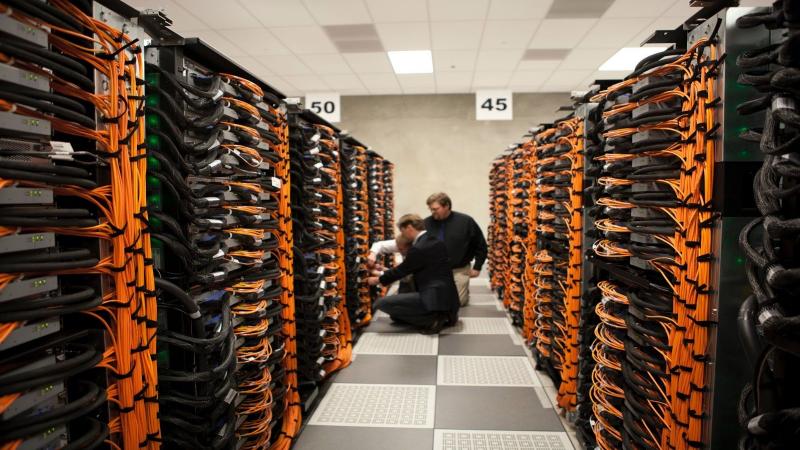
Photo from Science in HD via Unsplash
Materials found in nature are not always useful for engineering purposes as they are, but scientists can modify them to bestow useful properties. For example, in communication technology, scientists alter the size, shape, and orientation of materials to change their interaction with light or electromagnetic waves of different wavelengths. The methods of fabricating metasurfaces — the nanometre-thick surfaces of modified materials — for specific applications have improved over the years. Scientists can now change the properties of light with the help of nano-sized metasurfaces instead of thick materials like optical lenses.
The interaction of metasurfaces and light is governed by the nature of electromagnetism laws, which physicists describe with a set of four equations they call ‘Maxwell’s equations’. Scientists fabricating metasurfaces solve these equations on computers to use light–matter interactions for technological innovations. These computations can take hours or even days, depending on the complexities of the designed surface. In a new study, researchers from the Indian Institute of Technology Bombay (IIT Bombay) have developed a novel numerical method to study the interaction of metasurfaces with light. The study, published in the journal Scientific Reports, was funded by the Department of Science and Technology, Government of India, and the Industrial Research and Consultancy Centre, IIT Bombay.
As an example system to demonstrate the power of their numerical method, the researchers made a metasurface consisting of a layer of silicon sandwiched between two layers of gold. They created four different designs by modifying the geometric shapes of the topmost gold layer, which is a few nanometres thick. By varying the thickness of the four designs, they created many more of the metasurfaces.
The researchers mathematically studied how each metasurface affects a specific property, called ‘polarization’, of the light shone on it. In addition to interacting with the incoming beam of light, metamaterials also amplify the intensity of the beam.
“The amplification makes it easier to detect small changes in the light shone on the surface,” says Mr Abhishek Mall, the first author of the study.
On the computer, the researchers virtually shined a light with certain polarization and aimed to generate light with the opposite polarization. “To do this, we have to solve Maxwell’s equations for input to each metasurface until we get the desired output,” says Abhishek. The numerical calculations that go into the solutions consume a lot of time and computing power. “Moreover, the design process is limited by human intuition, and it is incredibly hard to develop the intuition in accurately solving the equations,” says Prof Anshuman Kumar, a co-author of the study. To overcome these issues, they wanted to create a method to study the interaction between the light and the metasurfaces without having to solve Maxwell’s equations.
The researchers developed an algorithm that tells which geometrical design of the topmost gold layer in the metasurface is best suited to generate the desired output beam. The algorithm learns to create geometrical designs based on the optical response and progressively improves itself by comparing how close it is to the actual design. They independently solved Maxwell’s equations for the generated geometries and verified that the algorithm correctly predicted the optical response.
This technique is a form of Artificial Intelligence (AI). “Such AI-based technologies are everywhere today from our shopping lists, video recommendations, online advertising, assisted medical diagnosis, self-driving cars, and search engines,” says Prof Kumar.
Since solving Maxwell’s equations is a time-consuming affair, the team created another AI algorithm to mimic the solution of Maxwell’s equations itself. When they fed the geometry of the nanometres-sized gold layer to the algorithm, the output would show the corresponding optical response.
The researchers combined the two algorithms, which then, in essence, carries out the entire process of identifying the correct geometrical pattern for the desired response and validating it against Maxwell’s equations. The combined scheme takes only about 11 milliseconds to guess the geometric configuration correctly.
“When we have the algorithm functioning as expected, we just feed the optical response, and out comes the required geometry, including its validation,” explains Abhishek. Currently, devices that perform the same function as their metasurfaces are more than a millimetre thick. “The user of our algorithm, however, can specify any thickness needed,” he says.
The researchers used only four different kinds of geometrical patterns in the current study. “However, our AI-based algorithm could also create new, sophisticated metasurface designs that we did not specify,” shares Prof Kumar. This feature may be useful in generating metasurface designs with multiple applications. “Currently, we are implementing our algorithm to work with more stringent requirements that the user would like to specify. We also want these metasurfaces to be very light and thin, to achieve the best of both worlds,” he signs off.
This article has been run past the researchers, whose work is covered, to ensure accuracy.






